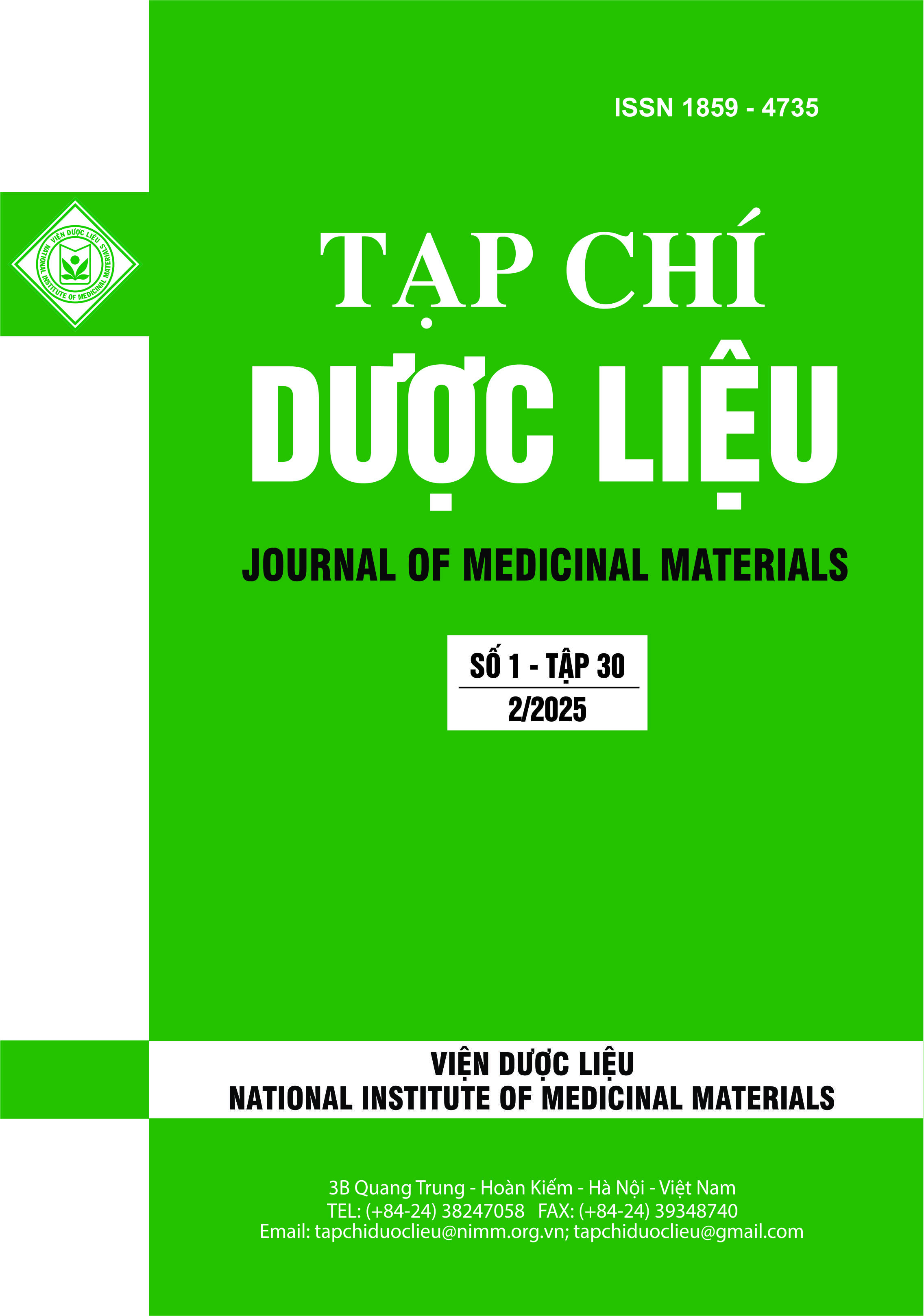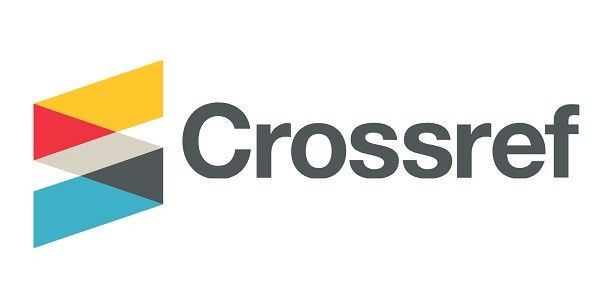
Tải xuống
Số lượt xem pdf: 125
Đã Xuất bản
Chuyên mục
Cách trích dẫn
Thành phần hóa học lá cây Maesa chisia D. Don (Primulaceae)
DOI:
https://doi.org/10.63240/jmm-nimm.2025.1.62Từ khóa:
Maesa chisia, Flavonoid, Sterol, Megastigman, SesquiterpenTóm tắt
Chi Maesa (họ Anh Thảo) bao gồm khoảng 200 loài có nguồn gốc từ các vùng nhiệt đới trên thế giới, trong đó có khoảng 20 loài phân bố ở Việt Nam. Các loài thực vật thuộc chi này đã được sử dụng trong y học cổ truyền để điều trị ho, các bệnh về đường hô hấp, gãy xương và eczema. Nghiên cứu thành phần hóa học của lá loài Maesa chisia thu tại Mường Tè, Lai Châu, chúng tôi đã phân lập được 7 hợp chất bao gồm kaempferol (1), acid vanillic (2), quercetin (3), clovane-2β,9α-diol (4), vomifoliol (5), daucosterol (6) và 3-O-(6′-O-palmitoyl)-β-D-glucopyranosyl stigmasterol (7). Cấu trúc của các hợp chất phân lập được xác định bằng phân tích phổ NMR, MS và so sánh với các dữ liệu được báo cáo trong tài liệu. Đây là nghiên cứu hóa học đầu tiên về loài M. chisia ở Việt Nam. Hợp chất 3-7 lần đầu tiên được tìm thấy ở chi Maesa.
Tài liệu tham khảo
1. Phạm Hoàng Hộ (1999), Cây cỏ Việt Nam, NXB Trẻ, Thành phố Hồ Chí Minh. 2. Võ Văn Chi (2012), Từ điển cây thuốc Việt Nam, NXB Y học, Hà Nội. 3. Barman A., Barman M., Das R., Ray S. (2023), Traditional medicinal uses, phytochemistry, bioactivities and toxicity of the genus Maesa (Primulaceae): A comprehensive review. Journal of Herbal Medicine, 100720. 4. Germonprez N., Maes L., Van Puyvelde L., Mai V. T., Tuan D. A., De Kimpe N. (2005), In vitro and in vivo anti-leishmanial activity of triterpenoid saponins isolated from Maesa balansae and some chemical derivatives. Journal of Medicinal Chemistry, 48, 32-37. 5. Germonprez N., Van Puyvelde L., Maes L., Mai V. T., De Kimpe N. (2004), New pentacyclic triterpene saponins with strong anti-leishmanial activity from the leaves of Maesa balansae. Tetrahedron, 60, 219-228. 6. Ngo M. T., Han J. W., Yoon S., Bae S., Kim S. Y., Kim H., Choi G. J. (2019), Discovery of new triterpenoid saponins isolated from Maesa japonica with antifungal activity against rice blast fungus Magnaporthe oryzae. Journal of Agricultural and Food Chemistry. 67(27), 7706-7715. 7. Midiwo J. O., Arot L. M. (1996), New dialkyl benzoquinones from fruits of Myrsine africana L. and Maesa lanceolata Forsk. Natural Product Letters, 8(1), 11-14. 8. Koike K., Kudo M., Jia Z., Nikaido T., Ide Y., Sakura T. (1999), New triterpenoid saponins from Maesa japonica. Journal of Natural Products, 62(2), 228-232. 9. Manguro L. O. A., Lemmen P., Ugi I., Kraus W. (2002), Flavonol glycosides of Maesa lanceolata leaves. Natural Product Sciences, 8(3), 77-82. 10. Jantas D., Malarz J., Le T.N., Stojakowska A. (2021), Neuroprotective properties of kempferol derivatives from Maesa membranacea against oxidative stress-induced cell damage: An association with cathepsin D inhibition and PI3K/Akt activation. International Journal of Molecular Sciences, 22(19), 10363. 11. Michalska K., Galanty A., Le T. N., Malarz J., Vuong N. Q., Pham V. C., Stojakowska A. (2021), New polyesterified ursane derivatives from leaves of Maesa membranacea and their cytotoxic activity. Molecules, 26(22), 7013. 12. Le N. T., Tran H. G., Vu T. K. O., Pham T. D., Dinh N. T., Stojakowska A., Truong B. N. (2021), Chemical constituents isolated from stems of Maesa membranacea. Vietnam Journal of Science, Technology and Engineering, 62(3), 15-18. 13. Shrestha I., Kunwar R. M., Bussmann R. W., Paniagua-Zambrana N. Y. (2021), Maesa chisia Buch-Ham. ex D. Don. Primulaceae. In: Kunwar RM, Sher H, Bussmann RW (eds) Ethnobotany of the Himalayas. Ethnobotany of Mountain Regions. Springer, Cham., 1223-1230. 14. Chakravarty A. K., Das B., Pakrashi S. C. (1987), Triterpenoid prosaponins from leaves of Maesa chisia var. angustifolia, Phytochemistry, 26(8), 2345-2349. 15. Chang Y. C., Chiang C. C., Chang Y. S., Chen J. J., Wang W. H., Fang L. S., Chung H. M., Hwang T. L., Sung P. J. (2020), Novel caryophyllane-related sesquiterpenoids with anti-inflammatory activity from Rumphella antipathes (Linnaeus, 1758). Marine Drugs, 18(11), 554. 16. Ren Y., Anaya-Eugenio G. D., Czarnecki A. A., Ninh T. N., Yuan C., Chai H. B., Soejarto D. D., Burdette J. E., de Blanco E. J. C., Kinghorn A. D. (2018), Cytotoxic and NF-κB and mitochondrial transmembrane potential inhibitory pentacyclic triterpenoids from Syzygium corticosum and their semi-synthetic derivatives. Bioorganic & Medicinal Chemistry, 26(15), 4452-4460. 17. Li Y. L., Li J., Wang N. L., Yao X. S. (2008), Flavonoids and a new polyacetylene from Bidens parviflora Willd. Molecules, 13(8), 1931-1941. 18. Khallouki F., Hull W. E., Würtele G., Haubner R., Erben G., Owen R. W. (2019). Isolation of the major phenolic compounds in the pits of brined green olive drupes: structure elucidation by comprehensive 1H/13C-NMR spectroscopy. Natural Product Communications, 14(7), 1934578X19857365. 19. Xiao Z. P., Wu H. K., Wu T., Shi H., Hang B., Aisa H. A (2006), Kaempferol and quercetin flavonoids from Rosa rugosa, Chemistry of Natural Compounds, 42, 736-737. 20. Liu H. Y., He H. P., Gao S., Chen C. X., Shen Y. M., Hao X. J. (2006), Two new diterpenoids from Callicarpa pedunculata. Helvetica Chimica Acta, 89(5), 1017-1022. 21. Huong P. T. T., Nguyen V. T., Diep C. N., Thao N. P., Cuong N. X., Nam N. H., Minh C. V. (2015), Antimicrobial compounds from Rhizophora stylosa. Vietnam Journal of Science and Technology, 53(2), 205210. 22. Faizi S., Ali M., Saleem R., Irfanullah-Bibi S. (2011), Complete 1H and 13C NMR assignments of stigma-5-en-3-Oglucoside and its acetyl derivative. Magnetic Resonance in Chemistry, 39, 399-405. 23. Lavaud C., Massiot G., Moretti C., Le Men-Olivier L. (1994), Triterpene saponins from Myrsine pellucida. Phytochemistry, 37(6), 1671-1677.


